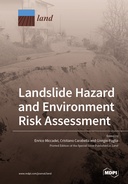Explore

Landslide Hazard and Environment Risk Assessment
0 Ungluers have
Faved this Work
Login to Fave
Landslides are among the most widespread and frequent natural hazards. Landsliding is linked to the combination of geological, geomorphological, and climatic factors in response to trigger mechanisms, mostly represented by heavy rainfall events, seismicity, or human action. Landslides directly and indirectly impact a territory, causing fatalities and huge socio-economic losses. Consequently, to avoid serious consequences and support sustainable territorial planning, there is a clear need of correct land use policies and best practices for long-term risk mitigation and reduction. In this context, geomorphological field activities, satellite remote sensing, landslide susceptibility mapping, and innovative GIS analysis offer effective support for mapping and monitoring landslides’ activity at both the local and regional scales. All landslide types are considered, from rockfalls to debris flows, from slow-moving slides to very rapid rock avalanches. Contributions to this Special Issue report key advances in landslide susceptibility mapping, environmental risk management in mass movement-prone areas, and landslide analysis in different geomorphological/morphostructural environments. Each article describes a distinct methodological approach to accurately investigate landslide phenomena and assess slope stability. Each article provides a scientific basis useful for the implementation of land planning, civil protection activities, and mitigation measures in different geological–geomorphological frameworks.
This book is included in DOAB.
Why read this book? Have your say.
You must be logged in to comment.
Rights Information
Are you the author or publisher of this work? If so, you can claim it as yours by registering as an Unglue.it rights holder.Downloads
This work has been downloaded 103 times via unglue.it ebook links.
- 103 - pdf (CC BY) at Unglue.it.
Keywords
- Abruzzo Region
- AHP
- bedrock topography
- Central Apennines
- climate extremization
- DGSDs
- DSGSDs
- early-warning
- environmental risk
- factor of safety
- fluvial terraces
- fuzzy analytic hierarchy process
- Geographical Detector
- geomorphological mapping
- geophysical characterization
- GIS
- GIS analysis
- Gran Sasso Massif
- Greece
- hazard
- hazard assessment
- heuristic
- historical landslides
- Hoek–Brown method
- hybrid modeling
- hydromechanical modeling
- hydroseeding
- information value
- interaction matrix
- Inventory
- Italy
- Kenya
- Kerala
- landslide
- landslide susceptibility
- Landslides
- large-scale landslides
- local factor of safety
- Machine learning
- mass movements-prone areas
- monoclinal setting
- morphostratigraphy
- morphotectonic
- multitemporal analysis
- n/a
- normal faults and overthrusts
- numerical models
- piedmont area
- rainfall-induced landslides
- Reference, information & interdisciplinary subjects
- Research & information: general
- Risk
- river capture
- Sardinia
- Sibillini Mts.
- slope
- slope stability
- snow avalanche
- soil sealing
- SoilNet
- susceptibility
- thema EDItEUR::G Reference, Information and Interdisciplinary subjects::GP Research and information: general
- triangular fuzzy numbers
- vegetation
- water content distribution
Links
DOI: 10.3390/books978-3-0365-3694-1Editions

